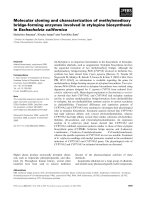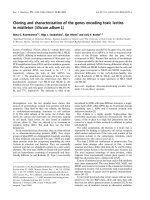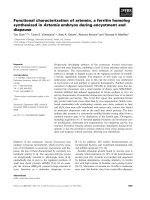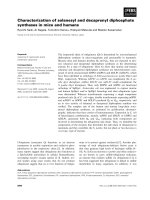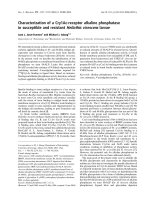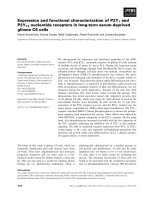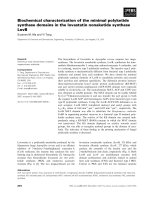Pathomechanistic characterization of DMT1 mediated manganese cytotoxicity implications in neurodegeneration
Bạn đang xem bản rút gọn của tài liệu. Xem và tải ngay bản đầy đủ của tài liệu tại đây (13.36 MB, 233 trang )
PATHOMECHANISTIC CHARACTERIZATION OF
DMT1-MEDIATED MANGANESE CYTOTOXICITY:
IMPLICATIONS IN NEURODEGENERATION
TAI YEE KIT
B. Sci (Hons), NUS
A THESIS SUBMITTED
FOR THE DEGREE OF DOCTOR OF PHILOSOPHY
DEPARTMENT OF PHYSIOLOGY
NATIONAL UNIVERSITY OF SINGAPORE
2013
Declaration
I
DECLARATION
I hereby declare that this thesis is my original work and it has been written by me in
its entirety. I have duly acknowledged all the sources of information which have been
used in the thesis.
This thesis has also not been submitted for any degree in any university previously.
Tai Yee Kit
05 January 2013
Acknowledgements
II
ACKNOWLEDGEMENTS
This thesis is the work of many hands.
I wrote it myself, indeed, but never quite alone.
So many others, the past and the present, by providence or design, helped shaped the
work that I’ve done for the past four years.
I could not have come thus far if it’s not for these people.
This is my modest attempt to thank a few.
To A/P Soong Tuck Wah,
for being a great mentor, the one who made this journey possible.
To A/P Lim Kah Leong, Dr.Katherine Chew, Dr.Ang Eng-Tat, Dr.Sharon Thio,
Dr.Nupur Nag, Dr.Loh Kok Poh and Dr.Calvin Yeo,
your discerning comments have been instrumental in making my thesis stronger.
To Bryce Tan, Zhi Rong, Sophia Yang, Tan Fong, Pey Rou, Mui Cheng and many
others at the National Neuroscience Institute and National University of Singapore,
your support made a lot of this journey possible.
To my family,
who supported and believed in me.
To my classmates, running mates, teachers and friends,
who encouraged and challenged me to become
the best of myself in every aspect of life.
Creator God,
You are indeed the intelligent designer.
Thank you for life and life abundant.
TAI YEE KIT
Table of Contents
III
TABLE OF CONTENTS
Declaration
Acknowledgements
Table of Contents
List of Figures and Tables
Abbreviations
Summary
I
II
III
VI
VIII
X
Chapter 1
1.1
1.2
1.3
1.4
1.5
1.6
1.7
1.8
1.9
1.10
1.11
1.12
Chapter 2
2.1
2.2
Introduction
Overview
Neurodegenerative Diseases
Metals in Neurodegenerative Diseases
Basal Ganglia and Movement Disorders
Basal Ganglia and Metal Ion Toxicity
Manganism
Parkinson’s Disease (PD)
Iron
1.8.1 Mechanism of Iron Transport and Cellular Metabolism
1.8.2 Transferrin-Mediated Iron Transport
1.8.3 Transport of Non-Transferrin Bound Iron (NTBI)
1.8.4 Divalent Metal Ion Transporter 1 (DMT1)
1.8.5 DMT1 and Neurodegenerative Disease
1.8.6 Cellular Iron Storage
- Ferritin
1.8.7 Labile Iron Pool (LIP) and Cellular Iron Regulation by
IRP/IRE System
1.8.8 Degradation of Iron-Regulatory Proteins
1.8.9 Mechanism of Cellular Iron Toxicity
Manganese
1.9.1 Mechanism of Manganese Transport and Cellular
Metabolism
1.9.2 Mechanism of Cellular Manganese Toxicity
c-jun-N-Terminal Kinase (JNK) and Cell Death
Neuroprotection and Management of Iron and Manganese
Toxicity
Rational and Objective
Materials and Methods
Materials
2.1.1 cDNAs
2.1.2 Antibodies
2.1.3 Reagents
Methods
2.2.1 Cell Culture and Western Blot
2.2.2 Calcein-Am Quenching Assay
2.2.3 MTT Cell Viability Assay
1
1
2
3
7
12
16
18
19
21
22
23
24
30
31
31
35
38
41
43
45
47
48
50
52
56
56
56
57
57
58
58
58
59
Table of Contents
IV
Chapter 3
3.1
3.2
2.2.4 RNA Extraction and RT-PCR
2.2.5 Immunocytochemistry and Confocal Microscopy for
Lysosomal and LC3 Puncta Staining
2.2.6 Intracellular ROS and Flow Cytometry
2.2.7 Densitometric and Statistical Analysis
2.2.8 Tail Digestion, DNA Purification and PCR
2.2.9 Brain Digestion and Western Blot
2.2.10 T2-Weighted Magnetic Resonance Imaging (MRI)
2.2.11 Proton-Induced X-ray Emi
ssion (PIXE) and Nuclear
Magnetic Resonance
2.2.12 Prussian Perls Iron Staining
2.2.13 Immunohistochemistry and Immunofluorescence of Brain
Sections
2.2.14 Rotarod Test
2.2.15 Fe
55
Uptake Assay
2.2.16 Biotin-Switch Assay
Results
Overview
Enhanced JNK Activation and Cellular Iron Depletion
Mediated by Mn
2+
Toxicity via DMT1
3.2.1 Expression of DMT1 and Fe
2+
uptake in DMT1
overexpressing cells
3.2.2 DMT1-mediated Fe
2+
and Mn
2+
uptake, cytoplasmic
accumulation and reduction in cell viability
3.2.3 Effect of Mn
2+
and Fe
2+
on MAP kinase pathway
3.2.4 Effect of Mn
2+
on autophagy pathway
3.2.5 Role of autophagy in Mn
2+
toxicity
3.2.6. Effect of Mn
2+
on iron storage ferritin protein
3.2.7 Involvement of ubiquitin-proteasome and autophagy-
lysosomal pathways in Mn
2+
-mediated ferritin degradation
3.2.8 Effect of Fe
2+
repletion (pre-treatment) on Mn
2+
-mediated
JNK phosphorylation
3.2.9 Effect of JNK inhibition on Mn
2+
-mediated ferritin
degradation
3.2.10 Effect of ferritin overexpression on Mn
2+
-mediated JNK
phosphorylation
3.2.11 Effect of JNK inhibition on Mn
2+
-mediated autophagy
activation
3.2.12 Intracellular ROS formation in Fe
2+
and Mn
2+
-treated cells
3.2.13 Effect of lysosomal inhibition on Mn
2+
-mediated JNK
activation
3.2.14 Effect of thioredoxin overexpression on Mn
2+
-mediated
JNK phosphorylation
59
60
60
61
61
62
62
62
63
63
64
65
65
65
67
67
70
71
74
80
88
93
97
98
103
107
108
110
116
119
Table of Contents
V
3.3
3.4
Chapter 4
References
Appendix
Publication
Characterization of Transgenic Mouse Model of Divalent
Metal Transporter 1 (DMT1)
3.3.1 Generation of MoPrP-DMT1B-myc transgene and
transgenic founder
3.3.2 Brain expression of DMT1B-myc
3.3.3 Brain iron content in DMT1_Tg measured using T2-
weighted magnetic resonance imaging (T2-MRI)
3.3.4 Brain iron content in DMT1_Tg measured using proton-
induced X-ray emission (PIXE) and histological Perls iron
staining
3.3.5 DMT1 and iron-mediated microglial activation
The Role of Nitric Oxide (NO) on DMT1 Function
3.4.1 NO increases DMT1-mediated Fe
2+
influx
3.4.2 NO-mediated S-nitrosylation of DMT1
Discussion and Conclusions
4.1 Part One
4.2 Part Two and Part Three
4.3 Future Works
Effect of Dietary Manganese and Iron on Rotarod
Performance of DMT1_Tg
A.1 Overview
A.2 Materials and Methods
A.3 Results and Discussions
124
124
126
129
131
134
139
139
140
143
144
152
159
162
207
207
207
208
211
List of Figures and Tables
VI
LIST OF FIGURES AND TABLES
1.1
1.1
1.2
1.3
1.4
3.1
3.2
3.3
3.4
3.5
3.6
3.7
3.8
3.9
3.10
3.11
3.12
3.13
3.14
3.15
3.16
3.17
3.18
3.19
3.20
Introduction
The nigrostriatal system and basal ganglia pathologies.
Basal ganglia diseases with metals accumulation.
DMT1-mediated transferrin dependent and independent iron uptake.
Putative DMT1 topology.
The IRP/IRE Regulatory System.
Results: Part One
Expression of DMT1 and Fe
2+
uptake.
Expression of exogenous GFP-
DMT1 localized to the plasma and
acidic lysosomal membrane.
Cytoplasmic accumulation of labile Mn
2+
.
Loss of cell viability in S-DMT1 cells treated with Mn
2+
, but Fe
2+
-
treated cells showed resistance.
JNK MAP kinase activation in Mn
2+
-treated S-DMT1 cells.
JNK inhibition and Fe
2+
treatment rescued Mn
2+
-mediated cell viability
loss.
Mn
2+
-mediated increase in autophagy reversed with Fe
2+
treatment.
Mn
2+
increased LC3 puncta formation in mRFP-GFP-LC3 transfected
cells.
Chemical inhibition of autophagy using unspecific
PI3K Class III
inhibitors, 3MA and WM did not rescue Mn
2+
-mediated cell viability
reduction.
Cell viability reduction in autophagy-deficient MEF cells treated with
Mn
2+
.
Mn
2+
-mediated downregulation of cytoplasmic ferritin.
Cytoplasmic ferritin loss was due to enhanced protein degradation
provoked by Mn
2+
.
Fe
2+
repletion (pre-treatment) and Fe
2+
co-incubation diminished Mn
2+
-
mediated JNK phosphorylation.
Mn
2+
-
mediated ferritin degradation is independent of JNK
phosphorylation.
Ferritin overexpression does not affect Mn
2+
-
mediated JNK
phosphorylation.
Mn
2+
-mediated autophagy activation independent of JNK activation.
Reduction in intracellular ROS with Mn
2+
treatment.
Lysosomal inhibition enhanced disruption to Fe
2+
homeostasis
mediated by Mn
2+
.
Effect of thioredoxin overexpression on Mn
2+
-
mediated JNK
phosphorylation.
Effect of thioredoxin overexpression on Mn
2+
-treated N2A cholinergic
cells and cell viability of Mn
2+
-treated S-DMT1 cells.
10
13
22
29
37
71
73
75
79
82
86
90
92
94
96
98
101
104
108
110
112
115
117
122
123
List of Figures and Tables
VII
3.21
3.22
3.23
3.24
3.25
3.26
3.27
3.28
3.29
4.1
A1
A2
Results: Part Two
Genotyping strategy and expression of DMT1B-myc.
Brain regional expression of the transgene.
Magnetic resonance imaging (MRI) and iron deposition in the brain.
Proton-induced X-ray emission (PIXE).
Histological Perls Prussian blue iron staining.
TH neurons and microglial activation.
Microglial activation associated with nitrosative stress.
Results: Part Three
Nitric oxide increases DMT1-mediated iron uptake.
S-nitrosylation of DMT1.
Discussions and Conclusions
A proposed model of cellular Mn
2+
toxicity via DMT1.
Appendix
Dietary manipulation strategy and weight of mice.
Rotarod performance of mice.
125
127
130
132
133
135
137
140
142
145
208
210
Abbreviations
VIII
ABBREVIATIONS
Biotin-HPDP
DAB
DMEM
DMSO
DPX
Cd
Co
ECL
EDTA
EGTA
ER
FBS
GSH
H
2
DCFDA
HEPES
HIF
LRRK2
I.P.
I.V.
MES
MMTS
MPTP
MTT
Ni
NOC-18
PBS
PFA
PINK-1
PVDF
RIPA
SDS-PAGE
SIN-1
SNAP
STEAP
pyridyldithiol-biotin
3,3'-diaminobenzidine
Dulbecco modified Eagle's minimal essential medium
dimethyl sulfoxide
di-N-butyle phthalate in xylene
cadmium
cobolt
enhanced chemoluminescence
ethylenediaminetetraacetic acid
ethylene glycol tetraacetic acid
endoplasmic reticulum
fetal bovine serum
glutathione
2',7'-dichlorodihydrofluorescein diacetate
4-(2-hydroxyethyl)-1-piperazineethanesulfonic acid
hypoxia-inducible factor
leucine-rich repeat kinase 2
intraperitoneal
intravenous
methyl methanethiosulfonate
4-morpholinoethanesulfonic acid
1-methyl-4-phenyl-1,2,3,6-tetrahydropyridine
dimethyl thiazolyl diphenyl tetrazolium salt
nickel
1-hydroxy-2-oxo-3,3-bis(2-aminoethyl)-1-triazene
phosphate buffered saline
paraformaldehyde
PTEN-induced putative kinase 1
polyvinylidene difluoride
radioimmunoprecipitation assay
sodium dodecyl sulfate polyacrylamide gel electrophoresis
3-(4-Morpholinyl)sydnonimine, hydrochloride
s-nitroso-n- acetylpenicillamine
six-transmembrane epithelial antigen of the prostate
Abbreviations
IX
TBST
VO
Tris-base saline with tween
vanadium
Summary
X
SUMMARY
Manganese (Mn
2+
) and iron (Fe
2+
) are essential trace elements required for many
biological functions. Cellular entry of Mn
2+
has been shown to be mediated by
divalent metal transporter 1 (DMT1), which was originally described for the transport
of Fe
2+
. Overexposure of manganese may result in neurological dysfunction
resembling Parkinson’s disease (PD). The accumulation of manganese in chronic
occupational exposures is associated with damage to the nigrostriatal dopaminergic
neurons. Yet, the pathomechanism underlying manganese toxicity is not well
characterized. As emerging evidence suggest a link between manganese overexposure
and iron deficiency, a better understanding of intracellular interplay between Fe
2+
and
Mn
2+
could help in the understanding and management of manganese toxicity. I have
shown that the cytoplasmic accumulation of Mn
2+
via DMT1 disrupted the labile iron
pool. This consequently resulted in the degradation of ferritin, an iron storage protein.
While one group showed that Mn
2+
could interfere with iron-regulatory protein 2
(IRP2), I provided evidence that the enhanced proteolysis of ferritin via autophagy
was to restore iron balance. Although I found that JNK activation was the major MAP
kinase responsible for Mn
2+
-mediated cytotoxicity, JNK activation was not associated
with autophagy activation or ferritin degradation. At closer examination, JNK
activation was found to be mediated by iron depletion via the ASK1-thioredoxin
pathway. Subsequently, another group also showed that iron-depletion using iron
chelators stimulated JNK and apoptosis. In addition, I also found that Mn
2+
reduced
intracellular superoxide levels, which suggested that Mn
2+
is an antioxidant. This led
us to believe that autophagy and JNK stimulation in the presence of Mn
2+
proceeds
independently of ROS. Finally, I also characterized the novel transgenic model
overexpressing DMT1, driven by mouse prion promoter for future iron and
Summary
XI
manganese neurotoxicity studies. Although the expression of DMT1 transgene was
widespread in the mouse brain, the substantia nigra (SN) showed marked iron
accumulation and signs of microglial activation. The increase in iNOS-derived nitric
oxide was associated with increase in nitrosative stress. As DMT1 was previously
shown to be indirectly modulated by nitric oxide via S-nitrosylation, here we
demonstrated that DMT1 could be modified directly by S-nitrosylation with
corresponding increase in iron transport. Taken together, my results offer a
mechanistic and functional explanation underlying manganese toxicity via DMT1 and
a possible interaction between nitric oxide and DMT1 in mediating
neurodegeneration.
Introduction
1
CHAPTER 1
INTRODUCTION
1.1 Overview
Divalent metal ions including iron (Fe
2+
), manganese (Mn
2+
), copper (Cu
2+
),
chromium (Cr
2+
), zinc (Zn
2+
), selenium (Se
2+
) and cobalt (Co
2+
) are essential trace
elements which are required for biological functions. The interplay between different
metal ion fluxes across cellular membranes exists as many of them share similar
transport mechanisms as well as the potential to bind to related proteins. Even though
metal ion toxicity is an uncommon condition, with exceptions in acute iron toxicity,
chronic trace metal ion intoxication could result in morbidity if left unrecognized or
treatment was inappropriately managed. Particularly, chronic occupational and
environmental exposures to manganese are widely accepted as potential hazards
causing the development of Parkinson-like syndrome called manganism. Parkinson’s
disease (PD), on the other hand, is an age-related neurodegenerative disease which
displays characteristic motor abnormalities and has been documented to present
homeostatic imbalances in trace metals. PD and several other basal ganglia diseases
are observed to show prominent increase in iron content in regions of pathology,
suggesting a possible role for iron in neurodegeneration. However, the major question
on whether abnormal iron accumulation is the initiating event in causing
neurodegeneration or a consequence of the disease progression remains unanswered.
As both manganism and PD are characterized by motor deficits associated with
pathology in the basal ganglia, epidemiological studies have shown possible
correlations between chronic manganese exposure and the risk of developing an
earlier onset of PD (Witholt, Gwiazda et al. 2000, Racette, McGee-Minnich et al.
Introduction
2
2001). With the mechanisms underlying competitive transport, metal handling and
neurotoxicity of iron and manganese still poorly understood, modern day treatments
for metal intoxication rely primarily on chelation therapies. However, the interaction
between essential trace metals in many aspects makes chelation therapy complicated
without having to compromise the physiological balance of other divalent metal ions.
Hence, the detailed understanding of cellular metal ion metabolism would provide
better clarification for the development of effective therapeutics, which may also be
beneficial for PD and other metal ion-related neurodegenerative diseases.
1.2 Neurodegenerative Diseases
Neurodegenerative diseases are brain diseases characterized by progressive
degeneration of neurons with corresponding loss of function. These diseases include
Parkinson’s disease (PD), Alzheimer’s disease (AD), Huntington’s disease (HD), and
amyotrophic lateral sclerosis (ALS). Many of these diseases show similar subcellular
pathological hallmarks which suggest that the degeneration process likely share
parallel intracellular and extracellular adverse events. While many inherited
neurodegenerative diseases feature rather selective pathological hallmarks and loss of
function affecting specific brain regions, these features are also observed amongst
patients without any underlying genetic mutations. Even as aging is a main
contributor towards the onset of disease, it is now accepted that environmental
trigger(s) plays a major risk factor in the development of sporadic neurodegenerative
diseases (Mattson and Magnus 2006). Increased in cellular protein burden due to
protein misfolding and impaired clearance, inflammation and oxidative stress are
common traits observed across all neurodegenerative diseases (Block, Zecca et al.
2007, Tai and Schuman 2008). While these traits are known to be the underlying
pathways driving disease progression, the initiating event remains unknown.
Introduction
3
Nonetheless, there is mounting evidence that suggest brain metal ion dysregulation is
likely to contribute to the pathomechanisms of these diseases, if not in influencing
their onset. Notably, iron dysregulation has been associated with HD, PD and AD
where iron were observed to preferentially accumulate in affected brain regions
(Mattson and Magnus 2006). Even as iron accumulates in the brain as a natural course
of aging, whether it is setting the stage for neurodegeneration remains unanswered.
Importantly, the reason for age-related iron accumulation and the underlying
mechanisms for selective neuronal deposition of iron in regions of pathology remain
elusive.
1.3 Metals in Neurodegenerative Diseases
The idea of a barrier system to the brain of the central nervous system (CNS) has
existed for nearly a century. The barrier system is classified into two systems of
which (i) the blood-brain barrier (BBB) separates the circulatory blood from the
cerebral interstitial fluid; while (ii) the blood-cerebrospinal fluid barrier (BCB)
separates the circulatory blood from the cerebrospinal fluid. Many studies have
pointed out that the brain barriers are vulnerable to neurotoxicants in the blood which
may compromise the integrity of these barriers. While certain brain pathologies such
as traumatic brain injury and meningitis (Sharief, Ciardi et al. 1992, Shlosberg,
Benifla et al. 2010) can result in the breakdown of the BBB and BCB, the normal
aging process is also suggested to be a main contributor to the disruption of these
barriers. Even though the association between the leakiness of the brain barriers with
aging and neurodegenerative diseases remains poorly understood, the abnormal
deposition of essential trace metals in the diseased brain may suggest such a
possibility.
Introduction
4
Essential trace metals are acquired through dietary sources and are important for the
maintenance of many biological functions. These metal ions are associated with
metalloproteins which are a part of the enzymatic and structural proteins. Even though
essential metals are likely to have a broad role in many aspects of cellular
metabolism, unwarranted uptake and bioaccumulation of metal ions can cause a
number of detrimental effects. Essential metals can become systemic toxins once
taken beyond the acceptable doses (either through the diet or occupational exposures)
into the body via oral ingestion, inhalation or dermal routes. Importantly, divalent
metal ions can enter the brain via cellular transport mechanisms on the BBB and BCB
or directly into the brain through the breach in these barriers. Once inside the brain,
metal ions can be deposited for decades and may potentially mediate the earlier onset
of neurodegenerative diseases (Markesbery, Ehmann et al. 1984, Gaeta and Hider
2005, Salazar, Mena et al. 2008). The aberrant accumulation of metal ions may also
suggest that faulty BBB and BCB may be due to their inefficient clearance from the
brain. Even though the accumulation of metals is evident with aging as well as in
neurodegenerative diseases, the hypothesis on whether the BBB and BCB are indeed
leaky requires further study (Quaegebeur, Lange et al. 2011).
The cytotoxic effect of many of these metal ions could be explained by their
capability to catalyze the formation of free radicals via redox cycling. Redox cycling
results in the increase in oxidative stress due to the formation of reactive free radicals.
Along with aging, free radical and oxidative stress hypotheses are believed to be the
major contributor in many neurodegenerative diseases and metal-related neurotoxicity
disorders. Metal ion-catalyzed oxidative stress can cause damage to DNA and
proteins (Kobayashi, Oikawa et al. 2008, Chew, Ang et al. 2011). Metal ions can form
adducts with proteins, rendering the protein dysfunctional and prone to cellular
Introduction
5
aggregation (Ly and Julian 2008). Divalent metal ions such as Fe
2+
, Mn
2+
and Cu
2+
contain an unpaired electron which allows their participation in redox reactions
through oxidation (loss on one electron) or reduction (gain of one electron). However,
the potential of metal ions to undergo oxidation and reduction is dependent on the
chemical structure as well as the stability of the metal ions in a biological system.
For example, iron in the ferrous form (Fe
2+
) is a pro-oxidant and has been shown to
catalyze the Fenton chemistry in the presence of hydrogen peroxide (H
2
O
2
). And as
iron accumulation in the basal ganglia has long been observed in many
neurodegenerative diseases, Fe
2+
-mediated ROS has been hypothesized to be the main
culprit for the selective loss of neurons. However, concrete evidence is still lacking to
establish causation for iron as the primary mediator in the neurodegenerative process.
Copper ion is another example of an essential metal of which uncontrolled redox
cycling of Cu
2+
is a source of free radicals. Both copper accumulation as well as
deficiency has been implicated in the neurodegeneration process in AD. The
accumulation of copper in the basal ganglia is observed in Wilson’s disease.
(Doraiswamy and Finefrock 2004, Lorincz 2010).
Interestingly, zinc ion (Zn
2+
) is a biologically stable species and does not readily
undergo redox cycling. Zinc is important for its function in many enzymatic proteins
and is especially crucial for its role in maintaining structural stability of many
proteins, through the formation of zinc-finger motif. Additionally, zinc ion can act as
an anti-oxidant that could replace other pro-oxidant divalent metal ions (such as,
Fe
2+
), and thus halting redox cycling. The displacement of Fe
2+
by Zn
2+
may have a
dual role in determining the fate of the cell, depending on the cellular redox status.
Intuitively, if excessive Fe
2+
is catalyzing the formation of ROS, then the
displacement of Fe
2+
by Zn
2+
is favourable. However, if the formation of ROS is
Introduction
6
required for cellular signalling, then the competitive inhibition of Fe
2+
by Zn
2+
could
compromise ROS-dependent cellular transduction pathways. Even though the
competition by Zn
2+
for Fe
2+
binding sites has been shown to be protective in cultured
cells against metal ion-catalyzed ROS, the application of such zinc therapy in treating
iron-mediated toxicity in animal model of neurodegenerative diseases remains
unexplored (Har-El and Chevion 1991). Although zinc overload and toxicity is
extremely rare, nonetheless, zinc has received tremendous attention of late due to its
protective role in many processes involving age-related neurodegenerative diseases
and in physiological brain aging (Mocchegiani, Bertoni-Freddari et al. 2005,
Hoogenraad 2011).
The relevance of Mn
2+
in ROS production remains controversial. It is required as an
important co-factor for mitochondrial superoxide dismutase (SOD2), where SOD2
functions to dismutate superoxide anion radical (O
2
·
-
) into water. Even though the
critical role of Mn
2+
in SOD2 to curtail excessive O
2
·
-
, Mn
2+
is biologically known to
be more toxic than Fe
2+
. It is likely that the toxic effect is mediated via Mn
2+
accumulation in the mitochondria leading to energy deficiency and ROS formation.
Unlike iron accumulation in neurodegenerative diseases, manganese accumulation in
the basal ganglia is associated with SLC30A10 mutations, environmental and
occupational exposures, long-term parenteral nutrition and well-waters contamination
(Dickerson 2001, Agusa, Kunito et al. 2006, Hardy 2009, Stamelou, Tuschl et al.
2012). As the complex interplay between manganese toxicity and brain iron
homeostasis exist, the association between manganese toxicity and neurodegenerative
diseases requires further investigation (Fitsanakis, Zhang et al. 2010).
Given that these trace metal ions are biologically important and may bind to common
proteins, the deficiency or overload of metal ions may have complicated implications
Introduction
7
on cellular functions. While many investigations revolve around the study of the
effects of metal ions individually, the study of the effects of uptake of two or more
metal ions and their interactions at the point of entry or their signalling pathways are
still lacking. Specifically, investigations at the intracellular level would shed light on
how different metal ions would lead to either convergent or divergent responses in the
hope that one day better tools for diagnostics could be developed and toxicity better
managed.
1.4 Basal Ganglia and Movement Disorders
In order to appreciate movement disorders and pathology related to the basal ganglia,
the knowledge on the role of dopamine in the basal ganglia and its associated circuitry
is important. Dopamine-producing neurons, also known as dopaminergic neurons, are
a group of heterogeneous cells in the brain which contain tyrosine hydroxylase (TH)
for the production of dopamine. As dopaminergic neurons lack the two downstream
enzymes for the production of norepinephrine (dopamine β-hydroxylase) and
epinephrine (phenylethanolamine N-methyltransferase), consequently dopamine is the
main neurotransmitter utilized by these neurons. Dopamine is synthesized as a
neurotransmitter in the presynaptic terminal, transported into synaptic vesicles and
released into the synaptic cleft upon arrival of electrical signals that trigger the
neurotransmission process. The initial step to its production involves the
hydroxylation of the amino acid tyrosine into L-3,4-dihydroxyphenylalanine (L-
DOPA) via the enzyme tyrosine hydroxylase. The enzymatic conversion of tyrosine
into L-DOPA by TH is the rate-limiting step in this biosynthetic pathway. L-DOPA is
then converted to dopamine by the removal of the carboxyl group from DOPA by
aromatic amino acid decarboxylase (AADC). Finally, the synthesized dopamine is
packaged into synaptic vesicles and ready to be released into the synaptic cleft.
Introduction
8
Released dopamine in the extracellular space is taken back into the presynaptic
terminal by dopamine transporters (DAT), where dopamine can either be recycled
into synaptic vesicles or degraded into 3,4-dihydroxyphenylacetic acid (DOPAC) by
monoamine oxidase type B (MAO-B). The flowchart below shows a simplified
dopamine biosynthesis pathway (Goldstein 1984).
Dopaminergic neurons can be found in several regions of the brain, including the
ventral tegmental area (VTA), substantia nigra (substantia nigra pars reticulata and
substantia nigra pars compacta), hypothalamus and olfactory bulb. Even as the basal
ganglia consist of a constellation of nuclei which are responsible for procedural
learning, cognitive and emotional functions, it is especially known for the execution
and coordination of motor movements. The basal ganglia receive important motor
inputs from the dopaminergic neurons in the substantia nigra and would eventually
influence the activity of the motor cortex via the thalamus. The role of dopaminergic
neurons in the control of motor function is more firmly established than other
functions due to its rather direct correlation of anatomical structures to the observable
outcome of motor function using pharmacological drugs (such as L-DOPA).
In addition, the nigrostriatal system is probably the most well-studied dopaminergic
pathway which has dopaminergic neurons projecting from the SNpc into the striatum
of the basal ganglia. And this system can undergo pathological degeneration of
unknown causes in Parkinson’s disease, leading to the removal of dopaminergic
innervations into the striatum and the development of characteristic motor deficits.
Introduction
9
As shown in Figure 1.1, the caudate nucleus and putamen, collectively known as
striatum, are identified to receive motor inputs from the motor cortex and thalamus
(cortical-thalamic pathway). The motor information are then processed and
channelled to its two output nuclei, the internal segment of the globus pallidus (GPi)
and substantia nigra reticulata (SNr). Interestingly, the striatum make connections
with its output nuclei by two pathways;
(i) Neurons in the direct pathway makes monosynaptic connections with the
GPi and to a lesser extent SNr, mediated by neurons containing Ɣ-
aminobutyric acid (GABA) and substance P as neurotransmitters.
GABAergic neurons are inhibitory neurons.
(ii) Neurons in the indirect pathway, as the name implies, also influence the
GPi and SNr, but only after going through several other nuclei. In this
pathway, the neurons from the striatum use GABA and enkephalins as
neurotransmitters. The neurons from the striatum projects to the external
segment of the globus pallidus (GPe), followed by connections from the
GPe to the subthalamic nucleus (STN) and finally reaching the GPi and
SNr output nuclei. Neuronal connections between the striatum, GPe and
STN are all mediated by GABAergic neurons while the final connections
between STN and the two output nuclei are mediated by glutaminergic
connections. Glutaminergic neurons are excitatory neurons.
Introduction
10
Figure 1.1. The nigrostriatal system and basal ganglia pathologies. A simplified schematic
presentation of the basal ganglia circuitry involving the nigrostriatal system (A) normal, (B)
Parkinson’s disease and (C) Huntington’s disease patients. The modulation of the cortical-thalamic
pathway is controlled by the direct or indirect pathways via the striatal control of the globus pallidus
(GP). The direct pathway involves striatal contact with the GPi (internal) and substantia nigra reticulata
(SNr) while the indirect pathway connects to the GPe (external), the subthalamic nucleus (STN) and
subsequently the GPi and SNr. Excitatory and inhibitory activities are represented by grey and black
arrows respectively. White arrow represents modulatory activity of SNpc on the striatum. Dashed lines
represent loss of dopaminergic neurons in the SNpc or GABAergic neurons in the striatum (Wichmann
and DeLong 1999, Gatev, Darbin et al. 2006).
Depending on the nature of the incoming motor input, the output nuclei (GPi and
SNr) would in turn influence the motor nucleus of the thalamus. The direct and
indirect pathways have antagonistic functions on the thalamus, where the activation of
the direct pathway is excitatory while the activation of the indirect pathway is
inhibitory. Hence, the balance of these two antagonistic pathways is modulated by the
Introduction
11
fine-tuning signals from the dopaminergic innervations of the SNpc to the striatum
(Alexander and Crutcher 1990).
There are two unique sets of dopamine receptors found in the basal ganglia.
Dopamine released from the striatal dopaminergic neurons of the SNpc result in the
activation of direct pathway via D1 receptors and at the same time exerting an
inhibitory effect on the indirect pathway through D2 receptors. Thus, in PD, the loss
of SNpc neurons is observed as a dysregulation to the balance of these two pathways.
The reduction in activity to the direct pathway with concordant increase in indirect
pathway activity leads to the hyperstimulation of the GPi and SNr. As these two
nuclei projects into the thalamus via GABAergic innervations, their hyperactivity
results in the enhanced inhibition to the motor nucleus of the thalamus. Consequently,
the lack of stimulation from the thalamus leads to the inhibition of cortically-initiated
movement and hence producing hypokinesia seen in PD patients.
Unlike hypokinesia observed in PD patients, an example of hyperkinesia due to the
reduced inhibition to the cortical-thalamic pathway is seen in HD patients. In HD,
early pathology is often associated with damage to the neurons in the striatum,
resulting in a set of rather characteristic motor symptoms such as jerky and random
movements and uncontrolled involuntary movements called chorea (Walker 2007).
These abnormalities are a consequence of degeneration in the striatal neurons leading
to the GPe. As a result, the disinhibition of the indirect pathway leads to the enhanced
inhibition to the STN and a net reduction in basal ganglia inhibitory output to the
cortical-thalamic pathway, leading to hyperactivity (Wichmann and DeLong 1996,
Wichmann and DeLong 1999).
Introduction
12
1.5 Basal Ganglia and Metal Ion Toxicity
Over the past decade, there has been a rising interest in understanding the
pathological mechanisms of essential transition metals and their influence on
neurodegenerative diseases. These metal ions, in particular iron and manganese have
been associated with the development of an earlier onset of neurodegenerative
diseases as well as the severity of the diseases. Increased exposures and excessive
uptake of metal ions into the brain due to dysregulation to transport may result in their
accumulation. Yet, the understanding of metal ion uptake and metabolism in the brain
is still largely unknown. The topological accumulation for each metal ion in the brain
is not uniform. Using various methods, it was found that selective deposition of metal
ions does reflect selective neuronal vulnerability in specific brain region for some
metals (such as iron and manganese); while the role of other metal ions (such as
aluminium, copper and zinc) is still poorly understood. In addition, abnormal metal
ion accumulation is often found in the nuclei of the basal ganglia, of which pathology
in the basal ganglia is responsible for a several motor diseases. Basal ganglia diseases
are a group of motor-associated neurodegenerative diseases exhibiting movement
disorders due to irregularities in the basal ganglia output into the cortical-thalamic
circuitry. As discussed, the basal ganglia output generally exert an inhibitory effect on
the cortical-thalamic pathway to inhibit competing motor pathways and ensure a
smooth and controlled execution of movement. However, any unwanted increase or
decrease in the inhibition output to the cortical-thalamic pathway can lead to motor
disturbances in the form of hyperkinesia and hypokinesia, respectively (Mink 1996).
With the exception to rare autosomally-transmitted basal ganglia diseases, the
etiology of most basal ganglia diseases remains elusive. Table 1.1 shows a list of
idiopathic and genetically-inherited (familiar) basal ganglia diseases.
Introduction
13
Reference
(Dexter, Jenner et al.
1992; Antonini,
Leenders et al. 1993
(
Savoiardo, Girotti et al.
1994
, Boelmans, Holst et
al. 2012
)
(Dexter, Jenner et al.
1992, Vymazal, Righini
et al. 1999)
(Bartzokis, Cummings
et al. 1999, Rosas,
Chen et al. 2012)
(Hayashi, Yano et al.
2006, Quintana 2007)
Brain regions with metal
accumulation
Predominantly in the
substantia nigra. Minimal in
the caudate and putamen.
Caudate nucleus, globus
pallidus, and putamen.
Minimal in the substantia
nigra.
Globus pallidus and
putamen. Minimal in the
substantia nigra.
Several cortical regions as
well as the globus pallidum
and putamen.
Caudate and putamen.
Metals
Iron
Iron
Iron
Iron
Copper
Cardinal Motor
Symptoms
Parkinsonism traits
(Resting tremors,
bradykinesia, postural
instability and rigidity).
Instability and lunging
forward with fast walking.
Akinetic rigidity.
Chorea (Abnormal
involuntary movement).
Parkinsonism with
increase episodes of
migraines and seizures.
Pathogenesis
95% sporadic,
5% inherited
99% sporadic,
1% inherited
Unknown
Autosomal
dominant.
Mutation to
Huntingtin
Autosomal
recessive.
Mutation to
ATP7B
Basal Ganglia
Disease
Parkinson’s disease
(PD)
Progressive
supranuclear palsy
(PSP)
Multiple systems
atrophy (MSA)
Huntington’s
disease
(HD)
Wilson’s disease
(WD)
Table 1.1. Basal ganglia diseases with metal accumulation.

